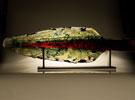
展览时间:2011-01-26 ~ 2011-03-15
展览地点:奥沙艺术空间
策 展 人:陈维德
参展艺术家:陈杰、龚剑、小林正人、李绫瑄、李杰、林明弘、刘韡、杨诘苍、赵赵
展览介绍:
《表征的重负:当今亚洲抽象派》将探索当今亚洲抽象绘画,并集中探讨亚洲艺术家如何不断重新思考「抽象」及「表征」两者之间的关系:抽象,在何等程度上是关于纯形式,其对现实的象征或关系,或者是关于表征其所「不可再现」的?展览将揭示抽象画处于亚洲的不同定位,以及凸显抽象主义如何成为绘画的多重思考,包括在政治及社会层面上,的汇合点。在写实与现实式绘画主宰的背景下,这反而论证了抽象画的多种可能性以及其对当今文化生产的重要性。
杨诘苍之作品表现了中国绘画的转变,亦为本展览之出发点。杨氏的《千层墨》系列由中国传统水墨画出发,深入至对绘画的了解,着重于绘画的物质感及物化的性质,以达至真实世界的表征。中国绘画亦曾出现此类抽象画的问题。当时中国绘画以形象主导,抽象及形象的对立对照于战后欧美艺术出现的社会主义及抽象表现主义的对立。而于八十年代的中国,抽象亦被视为社会现实主义的对立,正因前者强调自我表达及主观性,而后者则为集体表达的对抗。
除政治外,此展览亦同时探讨抽象画在今日亚洲的定位。陈杰的作品延续了丁乙以过程为本的创作,探索绘画的过程及影像的建造。李绫瑄的作品加以探讨绘画的物质性,如何以绘画的物料、颜料、支撑、画布等去展示表征的一套新规范。龚剑于画布上重复地写出自己的思想与感情,从而带出文字、表征及情感的关系。
小林正人的作品探索抽象及简约抽象主义之间的关系,以及绘画的虚幻表征空间作为具有三维立体性真实空间之间的关系。小林创作不规则形状的单色画,揭示了简约主义如何成为西方现代形式主义的逻辑进化。然而,小林的作品除了强调画作的实际空间外,其闪烁及诱人的外观亦改造了整个空间,同时暗示作品实际可拥有的存在感。
李杰,林明弘和赵赵的作品和展览通过日常生活回归政治。他们的作品取材于日常生活环境的情况来呈现社会的新观点。林明弘画作中的花朵图案来自台湾社会广泛采用的传统装饰布料,颜色鲜艳,图案丰富,充满着强烈的神秘感和迷信色彩,与当代抽象设计中朴素简洁的线条形成对比,又是一种显示现代社会身份和品味的美学。 这极端的对比凸显了社会上经常存在的高低等的文化差异。林氏的画作强调花朵图案如何在今日全球化的年代成为高等艺术,如何失去与其根源,以及与台湾文化所坚持的工艺、传统、迷信和延续性之关系。
同样,李杰以在互联网上找到的家居布匹作为画作的起点,把布匹重新制成真正的画作,然后于日常生活中用作不同用途,例如n清洁布,枱布等。这些作品终于以「绘画」回归艺术,探讨艺术与生活之间的微妙关系。刘韡的作品则探讨大众传媒和现实生活的关系。他那些以几何图形组成的颜色领域画作源自受到干扰后的电视信号,这亦是刘韡的作品中一个主要的概念。而赵赵的画作则以自己在画室的对象和现象作为出发点。
这些艺术家的作品某些程度上显示大部份亚洲现代抽象艺术以代表日常生活为基础。亦说明艺术最终是为反映生活现实的方方面面,成为现实社会的表征。
The Burden of Representation explores the state of abstraction in Asia today. In particular, the exhibition examines how artists in Asia have been and are continuing to rethink abstraction’s relationship to representation. To what extent is abstraction about pure form, its representation or relationship to reality, or about representing the ‘unrepresentable’? The exhibition demonstrates some of the positions in abstract painting in Asia today, and highlights how abstraction has become a point of convergence for different ideas about painting, including the social and the political. This in turn demonstrates the possibilities for abstract painting and its significance for cultural production today, in a context dominated by figurative and realist modes of painting.
The works of Yang Jiechang mark an important transition in painting in China and a point of departure for the exhibition. Yang’s paintings from his 100 Layers of Ink series demonstrates the transition from traditional Chinese ink painting towards an understanding and emphasis of painting’s materiality and objecthood, and hence towards a representation of the real world. These engagements with abstraction happened during a time when figuration dominated the practice of painting in China, where the tensions between abstraction and figuration mirrored the tensions in post-war Euro-American art, between Socialist Realism and Abstract Expressionism. In 1980s China, abstraction was considered by the establishment as antithesis to social realism, as the former privileged self expression and subjectivity, as opposed to collective expression in the latter.
Apart from the political, the exhibition explores other positions in abstraction in Asia today. The work of Chen Jie continues the process based painting that Ding explored, looking at the processes of painting and construction of images. Jane Lee’s paintings extend this exploration of painting’s processes to painting’s materiality, examining how an engagement with painting’s materiality, its paint, support, canvas, etc., can result in new paradigms of representation. Gong Jian, meanwhile explores the relationship between text, representation and emotion through paintings made by the repetitive transcribing of his thoughts and emotions.
Masato Kobayashi’s paintings engage with the relationship between abstraction and minimalist objecthood, between the illusive representational space of painting and the real space that the paintings inhabit as three-dimensional objects. Kobayashi’s shaped monochrome paintings illustrate the tension and contradiction inherent within the representational paradigm of Western Modernist formalism, when minimalism emerged as its logical evolution. However, in addition to drawing attention to the real space in which the paintings are presented, Kobayashi’s shimmering and seductive paintings also transform the space and allude to the physical presence that painting can possess.
It is also through the everyday that the political returns in the exhibition, in the works of Lee Kit, Michael Lin, Liu Wei, and Zhao Zhao. Their work draws upon aspects of their everyday surroundings and environments to present new perspectives about society. The floral motifs In Michael Lin’s paintings are appropriated from traditional and widely used decorative fabric in Taiwanese society. The brightly-coloured and elaborate patterns, which are imbued with strong mythical and superstitious significance, contrast with the austere and clean lines of contemporary minimalist design, an aesthetic denoting class and taste in contemporary society. This jarring contrast is reminiscent of, and highlights the distinction between low and high forms of culture that persistently exists within society. Lin’s paintings emphasise how in this day and age of globalisation, the floral patterns, in their high art guise, lose their relationship to their origins, their association with Taiwanese culture’s adherence to notions of craft, tradition, superstition and continuity.
In a similar way, Lee Kit’s paintings take as their starting point, images of household cloths found on the internet. These are then reproduced as actual paintings and used in daily life for the purposes they are intended, as cleaning cloths, table cloths, etc. These paintings are finally returned to the context of art as paintings, thereby collapsing and exploring the intricate relationships between art and the everyday. The relationship between the mass media and the everyday is also explored in the work of Liu Wei. His seemingly geometrically composed, colour-field paintings are derived from television signals caused by disturbance, a central concept in his work. Zhao Zhao’s paintings meanwhile, similarly take as their starting point, the materials and phenomena he finds occurring in and around his studio space.
The works of these artists demonstrate that much of contemporary abstraction in Asia is rooted in some way, to the representation of the everyday. They testify to how art is ultimately tied to reflecting aspects of lived reality, how they are representations of our social reality.
Exhibition Duration:November 2010 – 31st December 2010
Reception:10:00am-18:00pm (Tuesday-Sunday)
ABOUT THE BURDEN OF REPRESENTATION: ABSTRACTION IN ASIA TODAY
Curator: Eugene Tan
Artists:CHEN Jie, GONG Jian, Masato KOBAYASHI, Jane LEE, LEE Kit, Michael LIN, YANG Jiechang, ZHAO Zhao
Venue:Osage Shanghai
Address:No.320 Xingguo Road, Changning District, Shanghai 200031
Tel:021-5671 3605
- 2011-04-30 ~ 2011-05-30出窍记·缪晓春个展
- 2011-04-29 ~ 2011-05-20静中人Figures of Silence —Michel Madore
- 2011-04-30 ~ 2011-05-14黑白
- 2011-05-28 ~ 2011-07-28四重奏——孟昌明水墨荷花作品展
- 2011-05-28 ~ 2011-06-24“远与近”意大利当代著名艺术家作品展
- 2011-05-28 ~ 2011-07-02底下有石头:杨心广个展
- 2011-05-21 ~ 2011-06-20湖滨诗境──Celest生态摄影展(续展)
- 2011-05-21 ~ 2011-06-05缓行——十二位八零后艺术家
- 2011-04-28 ~ 2011-06-05观天悟道——张国龙艺术巡展
- 2011-05-28 ~ 2011-07-10诺特·维塔尔:激浸




